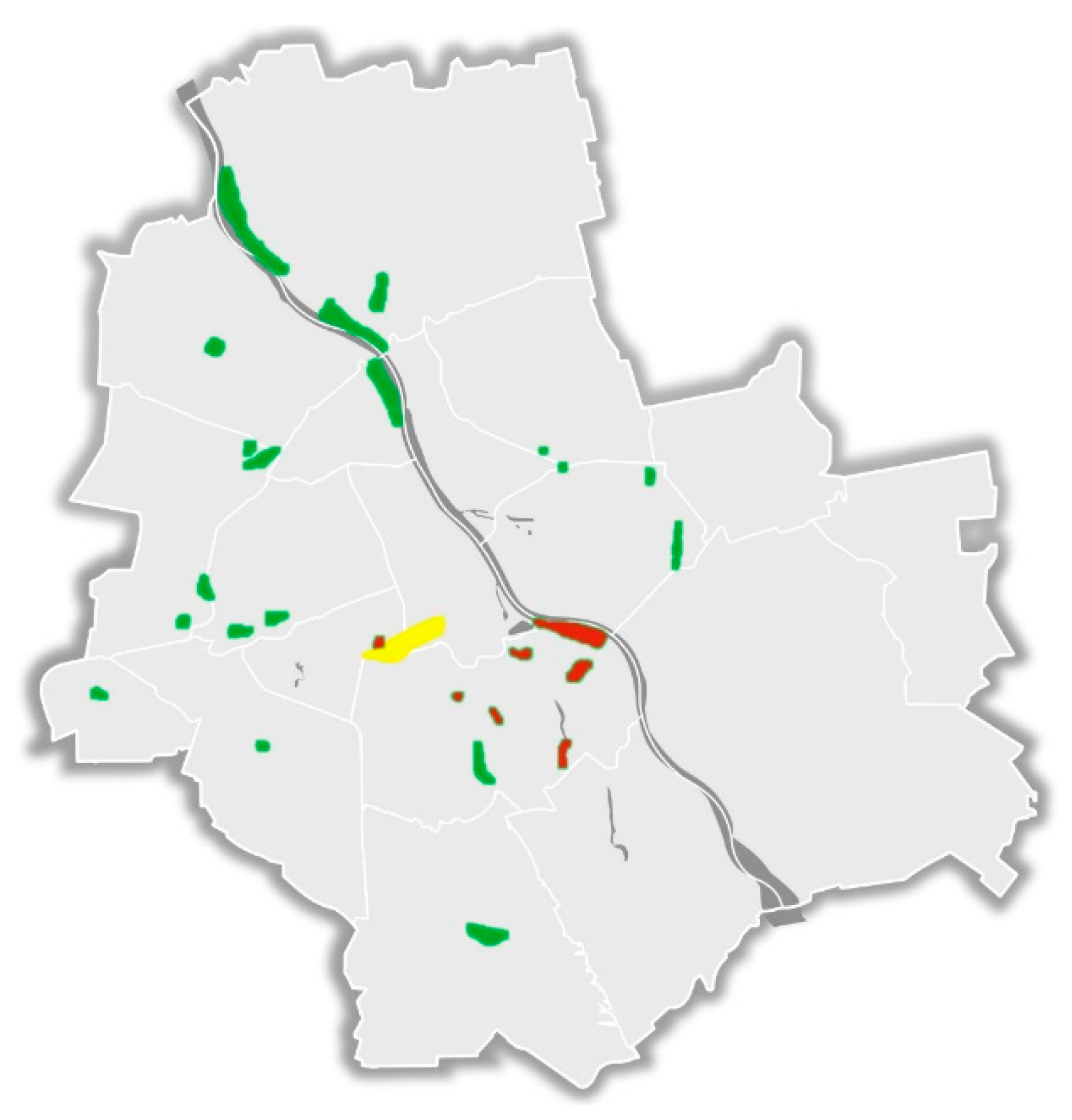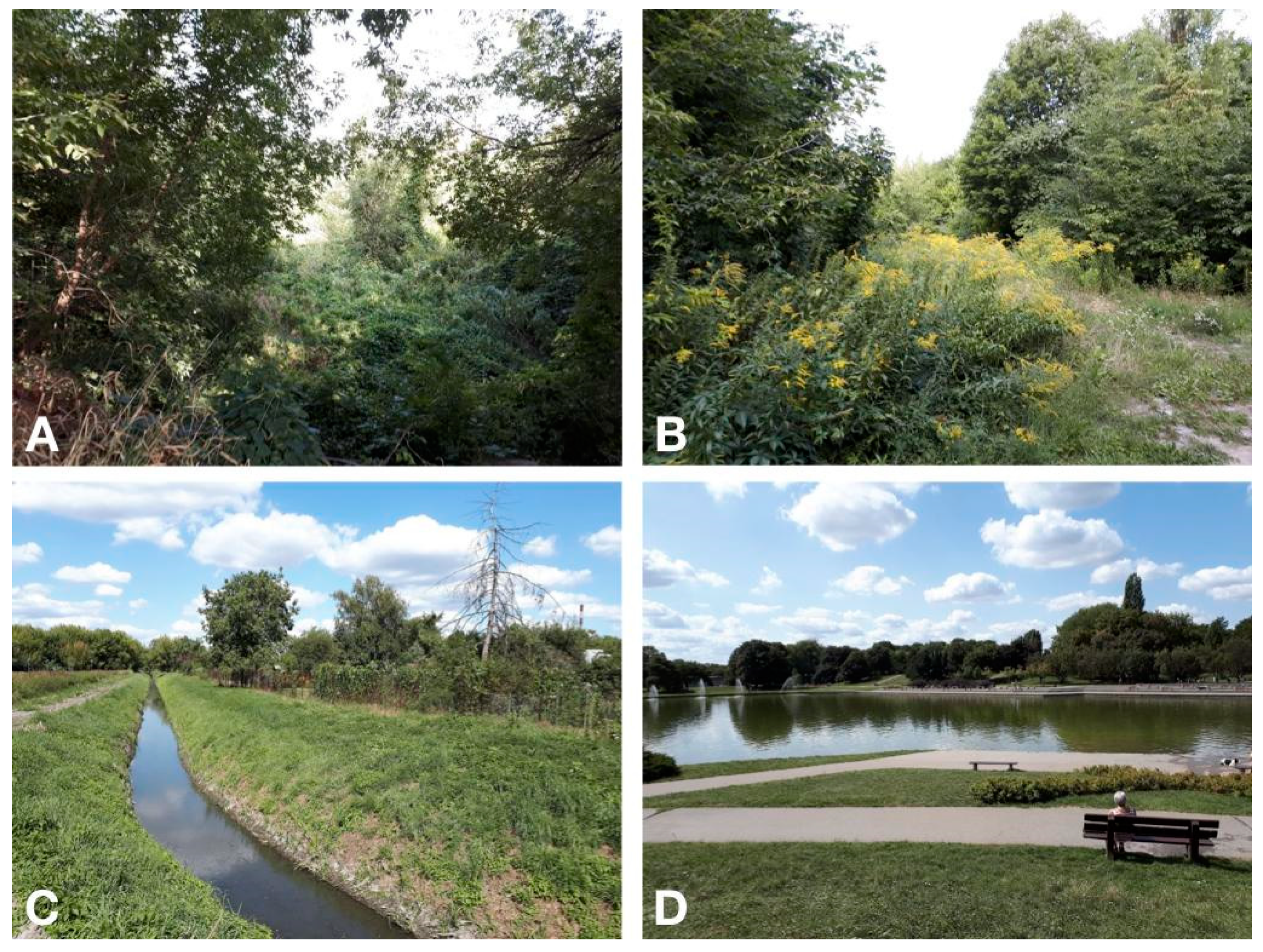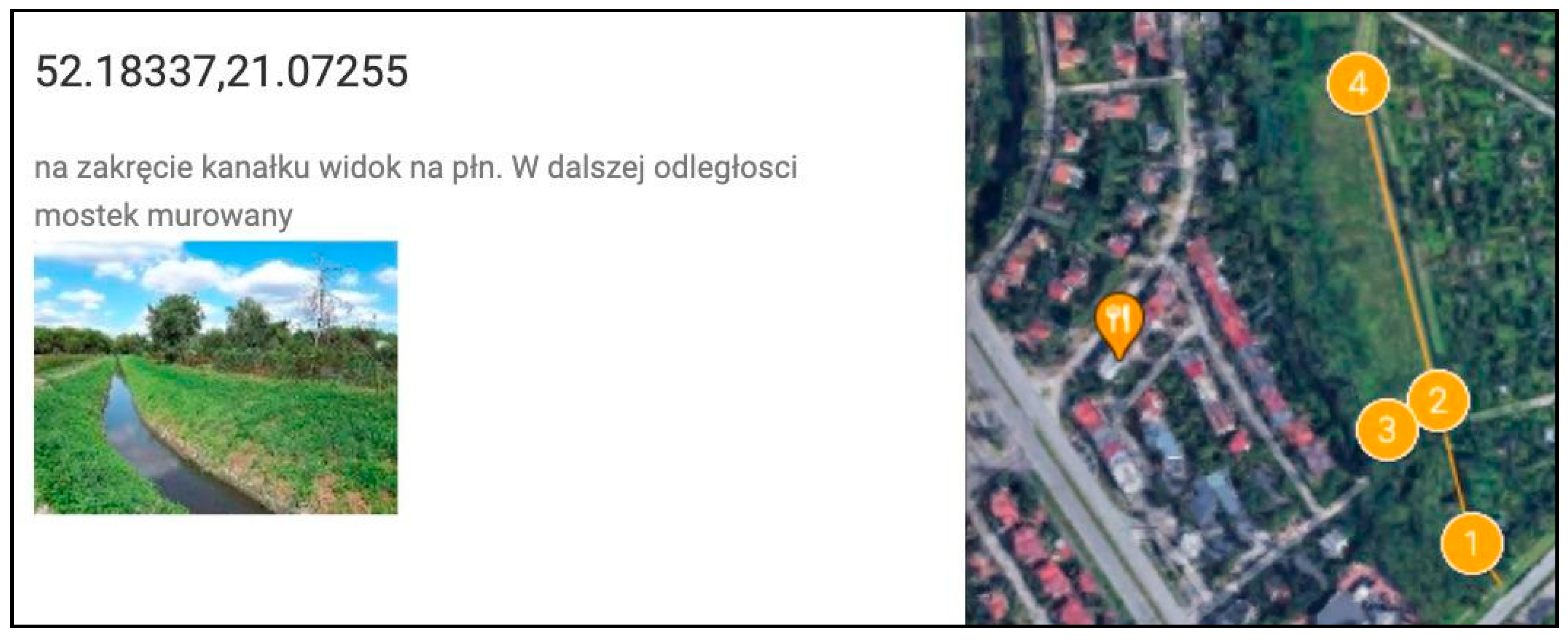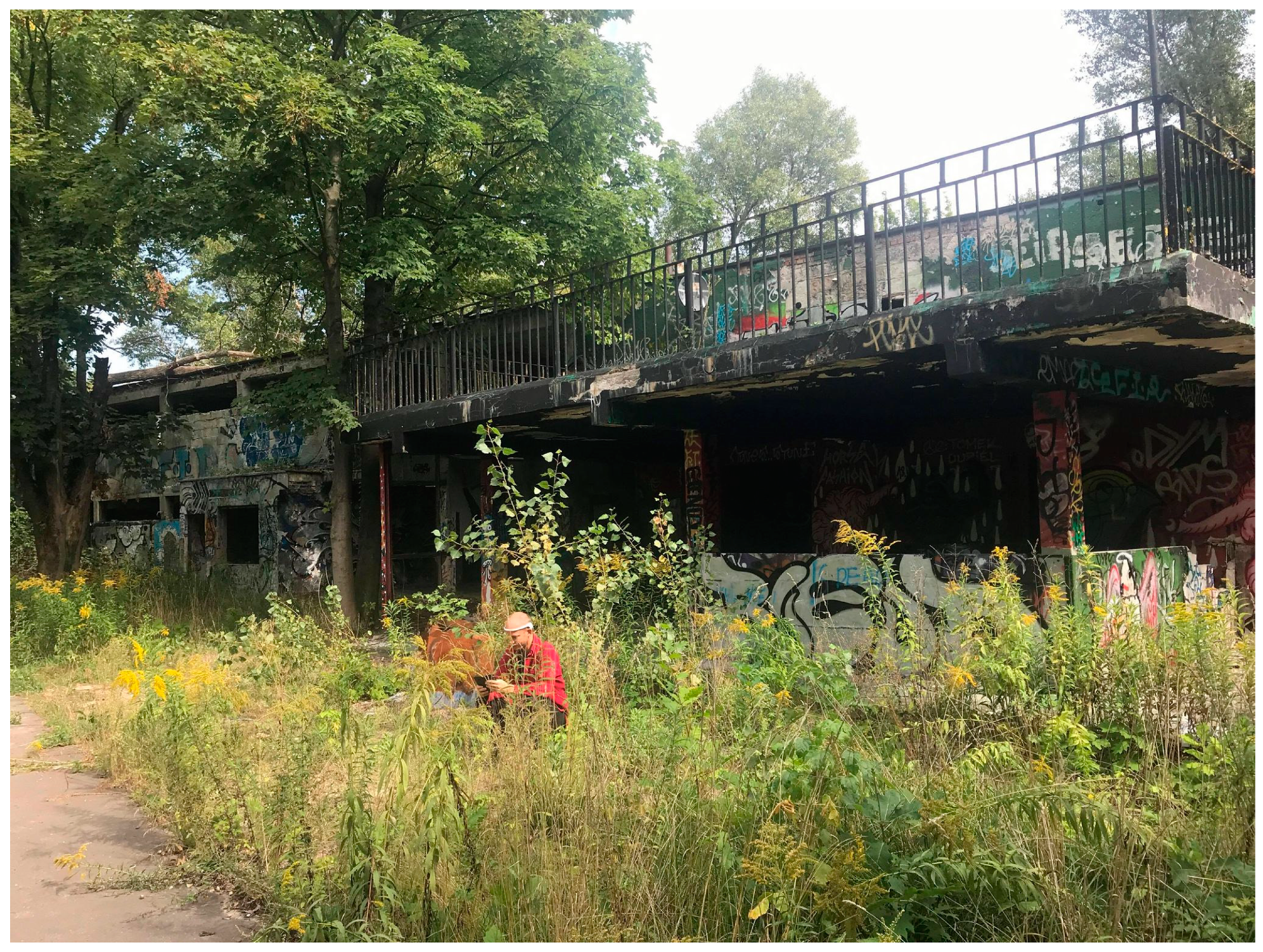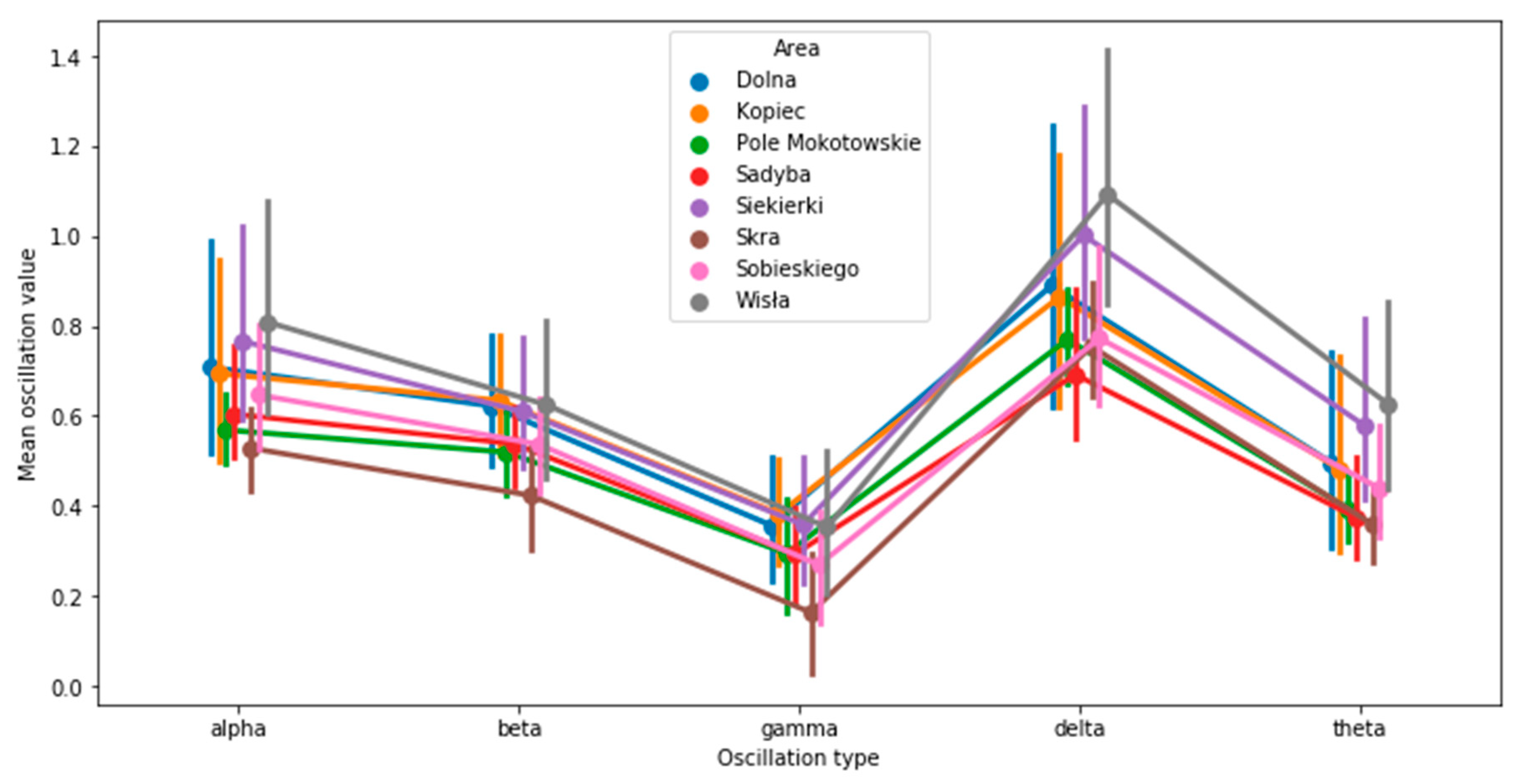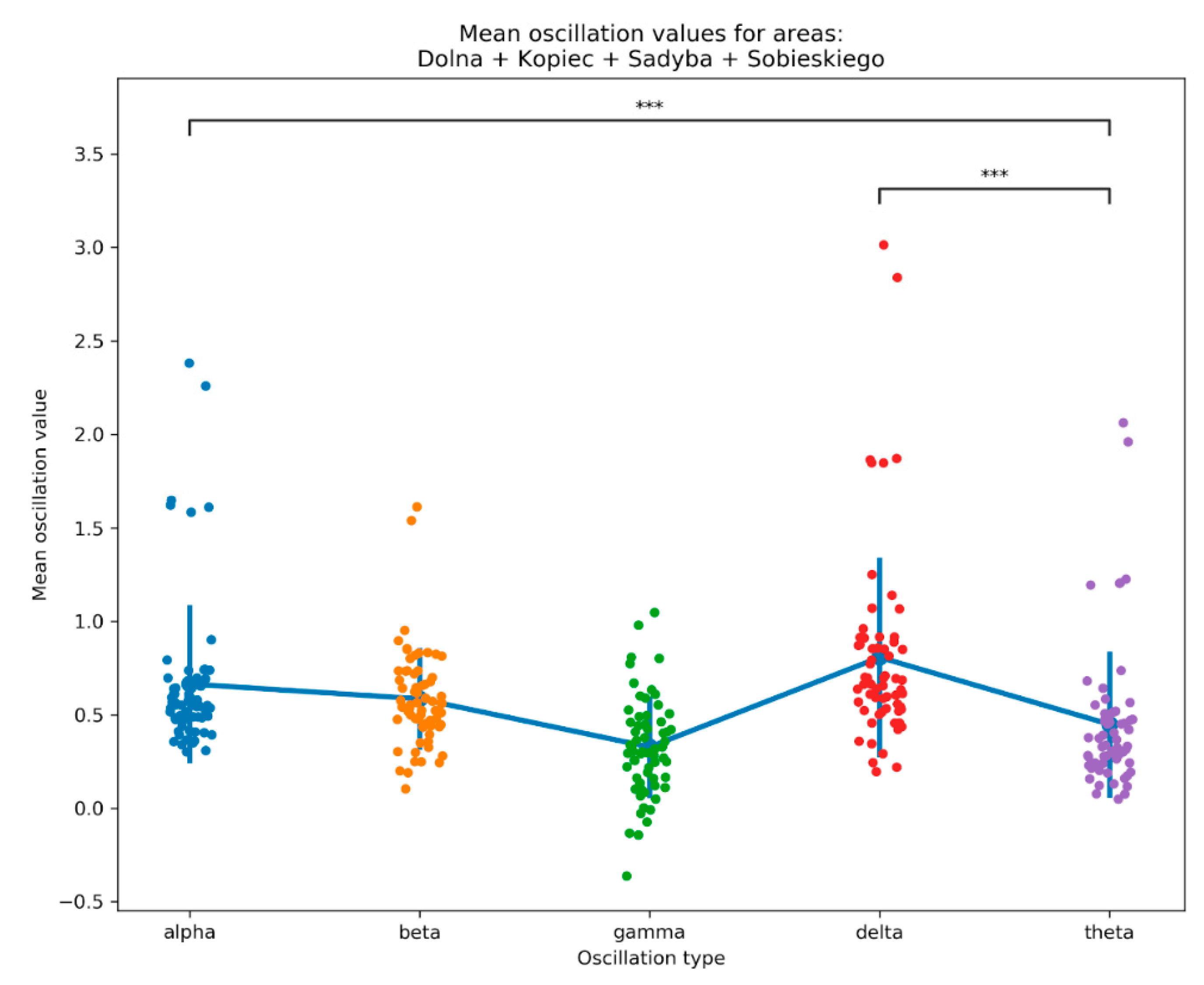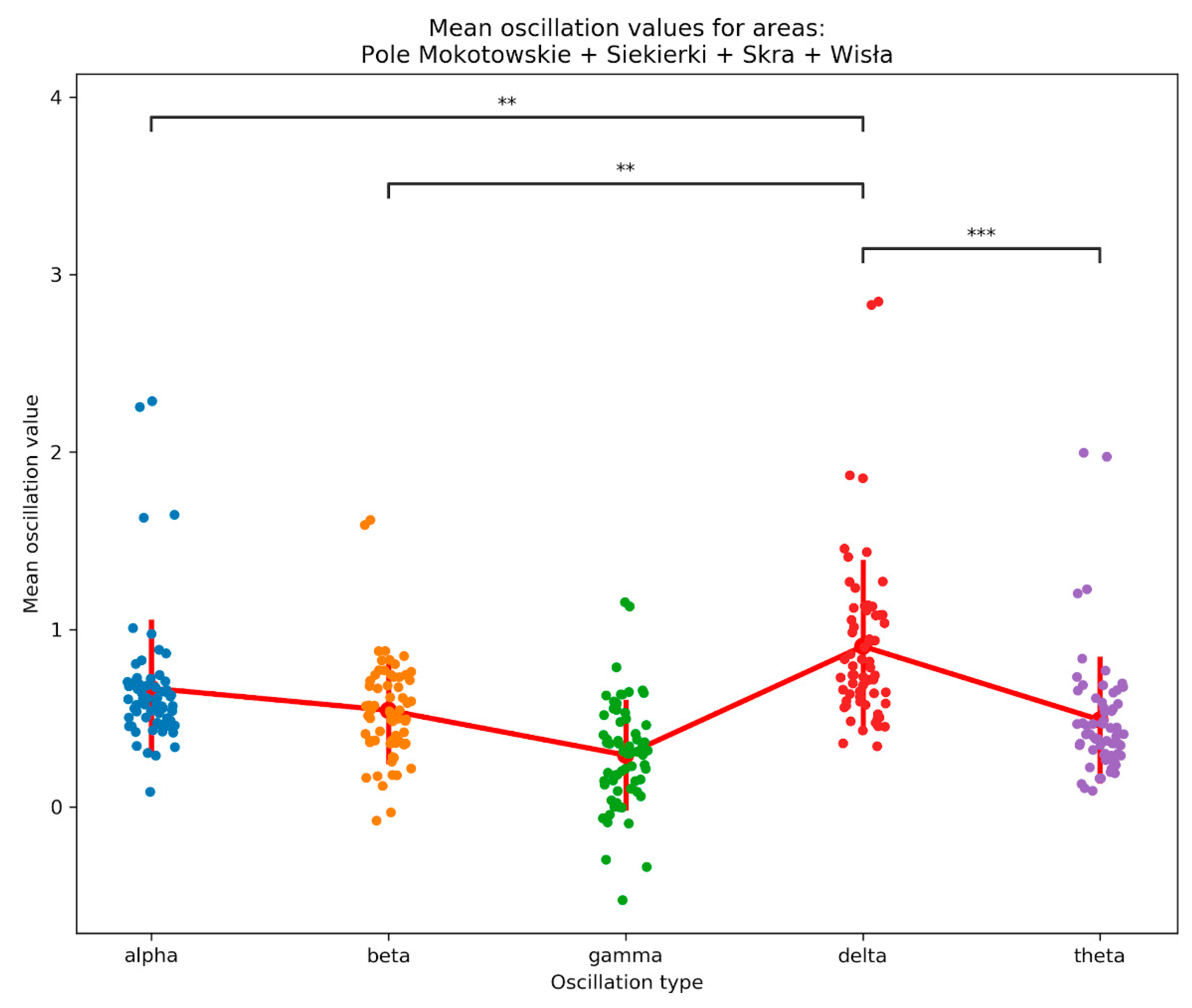2. Materials and Methods
2.1. Research Areas and Viewpoints
This experiment is part of a larger interdisciplinary research grant conducted in 2017–2019 by a multidisciplinary group of scholars from several departments at Warsaw University of Life Sciences in cooperation with the City of Warsaw. The goal of this project was to create an inventory and valorization of selected degraded and polluted areas in Warsaw measuring the natural and social potential of wastelands [
47]. An analysis of planning and zoning documents, ownership status, aerial photographs and several site visits resulted in a list of over 30 “green wasteland” areas (GWA) within the city limits of Warsaw, Poland. All these areas are recognized as brownfields or other types of wastelands with potentially contaminated soil, and are intensively or partially overgrown with spontaneous, uncultivated vegetation. Many of these lots of city-owned land are marked in planning strategies as potential areas for new urban parks and recreation spaces. All of them already play an important role providing ecosystem services. In later stages of the research, the term green wasteland was subsequently replaced with Informal Green Spaces (IGSs) as a term that better describes the character of the research subject.
Seven out of more than thirty identified IGSs were chosen for the purposes of this study (
Figure 1). Four characteristic points were chosen within each of the seven IGSs.
There were three selection criteria:
Diversity of scenery types. Viewpoints were selected to represent all 12 Warsaw IGSs scenery types as identified by Gawryszewska et al. [
46].
Table 1 presents the scenery types and number of scenery type instances for the 33 viewpoints. Some viewpoints are described by two types of scenery (e.g., road/path through low thickets). Viewpoints were selected to maximize the amount of scenery types and provide satisfactorily equal representation. This was a primary selection criterion.
Distance and connection between areas. In order to make it attainable for the participants, we delimited the scope of areas by choosing areas that are easier to reach with public transport. This helped to avoid long-distance travel for participants and also favored areas that were closer to the city center and dense urban fabric, residential areas.
Free public access. All areas but one were publicly accessible. One of them (Skra IGS) is fenced but publicly owned and unsupervised, and access through gaps in the fence was reasonably easy.
A reference area, one of the most popular, centrally located urban parks (a “traditional” green space—GS), was added to the seven IGSs. Five viewpoints were chosen around the Pole Mokotowskie Park. All in all, each participant was entrusted with the task of recording 33 sessions in 33 viewpoints within 8 areas.
Later on, an additional classification was added that was not one of the selection criteria: IGS type as categorized by Rupprecht and Byrne [
10]. This typology included (abandoned) “lots”, “brownfields” and “waterside” areas (
Appendix A), providing an opportunity for additional tests.
A short description of each of the research areas (
Figure 2):
Kopiec Powstania Warszawskiego IGS (Warsaw Uprising Mount, thenceforward referred to as “Kopiec”)—7.45 ha of a dense and mostly uncultivated greenery between a park-monument-mound, warehouses and a new development of multi-family buildings. Part of the area used as a parking/storage site during the construction works for the nearby highway. Vegetation consists partly of dense forest of approx. 40-year-old trees as well as some unmoved grasslands and low thickets (dense shrubbery).
Skra IGS—4.64 ha of a former sportsground with ruins of swimming pools and other accompanying facilities, overgrown and wild, with narrow paths, rubble and garbage as a sign of spontaneous parties; fenced with several (usually open) entrances; patches of Canada goldenrod and grass with some dense shrubbery and approx. 40-year old-trees; rarely used space—quiet and calm (a great contrast to the busy, nearby urban park—Pole Mokotowskie)
Pole Mokotowskie GS (Mokotów Field Park)—65 ha of a large urban park. Designed and built in the 1970s and 1980s. Considered to be the central park of Warsaw, it is busy with many activities including communication (bike lanes), amateur sports, food and drink consumption and dog walking. A former horse racing track and an airport, the park has large patches of older trees (planted from 1950s) as well as extensive mowed grass areas. The midpoint of this green space is occupied by a large concrete pond.
Dolna IGS—a small informal green space (2.49 ha) around a pond, mostly overgrown with reeds. An example of an “intermediate” space between “green wasteland” and urban park. It has areas of mowed grass and some sparse furniture (a few old benches) but no formal paths or arrangement. It is a well-used space (dog walkers from the nearby blocks of flats) and has some DYI elements such as a small track for mountain biking (the area is adjacent to the Warsaw escarpment). There is a noticeable presence or evidence of “undesirables” [
48] (people drinking alcohol etc.).
Sadyba IGS—5.71 ha—small forest area and grasslands (mowed once/twice a year) at the side of a small stream (ditch). It is not a very populated area, popular mostly with dog owners. There are a few narrow ground footpaths and proof of homeless people residing in the area.
Siekierki pod mostem IGS (“Siekierki under the bridge”)—another example of an intermediate green space (between IGS and GS). While not considered a park, it is a partially urbanized and developed area of 14.2 ha, under and next to a highway overpass, with several paved paths and some benches. Greenery around the two ponds is generally not cultivated with large areas of herbaceous monoculture.
Wisła (Vistula river) banks near Siekierki district—a large (50 ha) area of riparian forest, meadows and shrubbery, partially protected as a part of larger “Nature 2000” site “Middle Vistula Valley”). It is hardly used with very few paths leading towards the river.
Sobieskiego street ditch—a small, very narrow and overgrown IGS area (1.62 ha) along a large street and a ditch that is only temporarily filled with water. This area, perhaps because of its rather central location and dense tree/shrub cover, is populated by homeless people, who have created a small “camp” that is not visible from the main street.
2.2. Participants and the Procedure
The participant group consisted of n = 20 people (14 women, 6 men). These were landscape architecture students and volunteers recruited through social media posts. There was a modest remuneration offered for completing the full procedure in the experiment. Records of three participants were removed from the database before performing the analyses due to incorrectly collected data (their files from the Muse device were empty or incomplete). Thus, the final results come from analysis of recordings of n = 17 participants.
The experiment was designed to be independently executed by each of the participants, and each recorded session was executed individually (
Table 2 and
Appendix C). All participants underwent a short training and a short sample session with the apparatus. They were instructed by the researchers on how to perform the experiment—find designated viewpoints in research areas and operate the apparatus. They were also provided with a printed manual, a link to Google Maps with the exact location of each research viewpoint, its coordinates, description and an attached photograph of the view from the viewpoint (
Figure 3). After this, participants traveled between areas in a random order (
Appendix B), finding viewpoints and setting up the apparatus independently. Most participants chose biking as their method of moving between areas. Light foldable chairs were made available for comfort, though some of the participants chose to sit on the ground or blankets etc.
At the sites of the experiment, each time connectivity with the Muse headband had to be established with Bluetooth and checked for all four electrodes (TP9, AF7, AF8, TP10). After ensuring the proper connection of smartphones with Muse, the baseline phase of the experiment—the relaxation phase—was established. During this time, participants were asked to close their eyes and relax for 30 s while their EEG data were recorded by Muse (the baseline phase was later on used as a reference for analyzing changes in the signal (by being subtracted from the signal), hypothetically caused by communing with the environment in designated places). Next an alarm clock was set for 3 min and the recording session would start. During the 3 min sitting, participants would look at the view (landscape) without unnecessary movement. After saving the session, the participant would move to another viewpoint within the research area, repeating the same steps at each of them. Complete recording of sessions at 4 viewpoints (plus the transfer time) within one area would take between 30 and 60 min.
2.3. The Apparatus
The participants in the experiment were equipped with a Muse headband (
Figure 4)—a wearable brain sensing device. The device is fully portable and can be paired with any tablet or smartphone and operated with the Muse application. The application, apart from recording and preprocessing EEG data, can be used as a personalized meditation guide. Muse is equipped with 4 electrodes and collects electroencephalographic (EEG) signals from frontal areas (TP9, AF7, AF8 and TP10 electrodes); thus, it uses two channels on the left and two on the right, and can explore hemispheric asymmetries. Muse is also equipped with two micro-USB ports on the back of the ear pods where two auxiliary electrodes can be attached. These electrodes can be used to measure EMG, electrocardiography (ECG) or EEG on other areas of the body or head. The sampling frequency was 300 Hz. Participants were either provided a smartphone with an installed Muse Monitor application or had the choice of using their own smartphone.
2.4. Psychophysiological Indices
The EEG device tracks and records brain wave patterns. The sensors are placed on the frontal lobes of subjects. When brain cells (neurons) are activated, local current flows are produced. EEG measures mostly the currents that flow during synaptic excitations of the dendrites of many pyramidal neurons in the cerebral cortex. Differences in electrical potentials are caused by summed postsynaptic graded potentials from pyramidal cells that create electrical dipoles between the body of neurons and the dendrites. Brain electrical current consists mostly of Na+, K+, Ca++ and Cl− ions that are pumped through channels in neuron membranes in the direction governed by membrane potential [
49]. The detailed microscopic description includes different types of synapses involving a variety of neurotransmitters. In weak electrical signals detected by the scalp, electrodes are massively amplified and then stored to computer memory. Due to its capability to reflect both the normal and abnormal electrical activity of the brain, EEG has been found to be an insightful, although often difficult, technique in the field of neurology and clinical neurophysiology.
When analyzing the data, we focused on comparing the proportions of four types of oscillations: alpha (8–15 Hz)—indicating alertness, calmness and meditative states; beta (15–30 Hz)—indicating alertness, agitation, mental involvement, active learning and conscious processing of information; delta (0.5–4 Hz)—indicating deep sleep and calmness, but also excitement or stimulation when the delta waves are suppressed; theta (4–8 Hz)—indicating deep meditative states, dreams and automatic behavior [
50]. The gamma oscillations (25–140 Hz, with 40 Hz being the common point of interest), which are present on visualizations below, are correlated with large-scale brain network activity and cognitive phenomena such as working memory, attention and perceptual grouping, and can be increased in amplitude via meditation or neurostimulation [
51]. However, there is a controversy around using gamma in analyses, since its frequency band overlaps with muscle activity [
52]. It is advisable to preprocess the signal using, e.g., independent component analysis (ICA); however, in our case the study was not controlled in laboratory conditions, and therefore we decided not to use gamma waves in our interpretations. There are also other indicators of emotional arousal referring to the oscillation bands, such as the alpha asymmetry [
27]. However, there is an increasing critique of this type of measure, and therefore we have not used it in our analyses [
53].
EEG can serve as a reliable tool to measure stress [
54,
55,
56]. High stress response can be unveiled through results showing a decrease in high alpha power (11 to 12 Hz), as well as an increase in the high beta band (23 to 36 Hz, considered a “busy brain” indicator) and a decrease in the approximate entropy. However, various other physiological indicators of stress and calm are becoming increasingly used in outdoors research. Among others, researchers use psychophysiological feedback devices such as electrocardiography (ECG) [
57,
58] and skin conductance (SC) [
59] to detect the affective states of the users during task performance. Their increased application is related to the fact that measurements of the SC/GSR, EEG and HRV [
60,
61,
62] are considered to be adequate indicators of stress and calm. GSR is considered to be one of the most sensitive and valid markers of emotional arousal and is one of the most sensitive methods of capturing the autonomic nerve response [
63,
64]. GSR devices allow the capture of biomarkers of sympathetic nervous system activation. For instance, during high levels of emotional arousal, sweat secretion is intensely activated and can be captured with a GSR sensor. HRV, on the other hand, is used as an indicator to measure physical stress, and reflects the sympathetic and parasympathetic activities of the autonomic nervous system measuring the temporal difference between successive heartbeats in milliseconds (time between beats is called the R-R interval).
2.5. Statistical Analysis
The EEG signal from the Muse headband was recorded with the use of the
Muse Monitor mobile app (currently called
Mind Monitor). The sampling was set by the users to 500 Hz, with a 16 bit resolution, without a notch filter. The raw EEG data for each channel on the headband were measured in microvolts. Because of the Bluetooth connection, some of the EEG samples were dropped due to connection issues. However, there is a parameter in the final database that allows for identification of such samples and interpolation of the signal. The raw signal is later preprocessed with the use of Muse algorithms (
https://web.archive.org/web/20181105231756/, accessed on 13 November 2020,
http://developer.choosemuse.com/tools/available-data, accessed on 13 November 2020). The signal first undergoes a Fast Fourier Transform (FFT). This computes the power spectral density of each frequency on each channel. Basically, it shows which frequencies make up a signal, and “how much” of each frequency is present. Each path contains 129 decimal values with a range of roughly −40.0 to 20.0. Each array represents FFT coefficients (expressed as power spectral density) for each channel, for a frequency range of 0–110 Hz divided into 129 bins. The absolute band power for a given frequency range (for instance, alpha, i.e., 9–13 Hz) is the logarithm of the sum of the power spectral density of the EEG data over that frequency range. It is provided for each of the four channels/electrode sites on Muse. Since it is a logarithm, some of the values will be negative (i.e., when the absolute power is less than 1). It is given on a log scale, and the units are bels. This is the final data type we have used for analyses. The developers of Muse provide an experimental metric of “mellow” and “concentration” scores; however, we have not used them, since the developers warn that they are “highly experimental” and do not provide any information about the characteristics of the algorithm.
In order to prepare the data for analysis, we carried out additional preprocessing and then statistical analyses using Python programming language (with the libraries scipy, statsmodels and scikit_posthocs). At first, the signal was reviewed in terms of the number of non-informative elements and errors (e.g., missing data, non-numeric values, poor signal quality obtained from a particular electrode, dropped samples etc.). The Muse dataset also provides an annotation of eye blinks and jaw clenches, which may produce artifacts in the signal. Therefore, such samples were removed from the signal. Then, we subtracted the 30 s baseline (relaxation phase of the study) from the rest of the signal, for each area and for each participant separately. Subsequently, we averaged the absolute band power of the five oscillations for each session in the parks as well as for each person, for later comparisons.
After the preprocessing of the data and extraction of all 5 oscillation bands, we carried out analysis of variance (ANOVA) with repeated measures (with Sidak’s correction for multiple comparisons), where the mean oscillation power/values for each location were the dependent variables, and the type of park and type of oscillation were independent variables.
For the data-driven analyses, we again carried out analysis of variance (ANOVA) with repeated measures (with Sidak’s correction for multiple comparisons), where the mean oscillation power/values for each location were the dependent variables, and the type of oscillation was an independent variable.
3. Results
In the initial phase of data analysis, we focused on three tests based on literature-derived typologies. The hypothesis for the first test was that there is a connection between emotional well-being (states of calmness and alertness) and the type of viewed scenery. Based on the scenery typology for Warsaw IGSs developed by Gawryszewska et al. [
46] (
Table 1 and
Appendix A), four groups of scenery types were used in the analysis. The first group consisted of the wildest sceneries (low thickets and wilderness), the second of cultivated grasslands (mowed grasslands, “savannah”), the third of rarely cultivated low vegetation (herbaceous monoculture, unmowed grasslands) and finally the fourth group of scenery with tree-cover (light forest, sparse tree-cover). The second test was a straightforward analysis of all IGS areas versus one GS (Pole Mokotowskie Park) area. The third test took into consideration possible connections between emotional well-being and IGS type as categorized by Rupprecht and Byrne [
10] (
Appendix A). These three tests did not bring any statistically significant differences within the described groups.
Due to this, we looked into other significant results using a different methodological approach. A data-driven analysis was carried out, this time grouping areas with varying differences between oscillations. We carried out multivariate analyses of variance in the repeated measurement scheme. The compared variables were the power of individual oscillations (alpha, beta, delta, theta) for a given area (
Figure 5). First of all, we checked whether there were any significant differences in the oscillations between sexes. There were none—all gender differences in oscillations were on levels of
p > 0.05.
The results of the analyses showed that in “Dolna”, “Kopiec”, “Sadyba” and Sobieskiego Street areas, subjects had statistically significant differences between the alpha and theta oscillations (
p < 0.001) and between the delta and theta oscillations (
p < 0.001) (
Figure 6,
Table 3). This may mean that in these environments, subjects remained vigilant but at the same time felt calm. However, the calmness level cannot be compared with that achieved in the state of deep meditation.
The situation differs slightly in the case of “Pole Mokotowskie”, “Siekierki”, “Skra” and “Wisła” areas. Here, the greatest power was characteristic of the delta oscillations, which differed significantly from alpha (
p = 0.005), beta (
p = 0.005) and theta (
p < 0.001) oscillations. This may indicate that the subjects were much calmer and less alert in these areas (
Figure 7,
Table 4).
4. Discussion
The results of this experiment bring to attention two possible interpretations. The first interpretation is that there is not much difference between how spending time in informal green space and green space areas, respectively, influences our emotional well-being. The experiment was conducted in both GS and IGS, in a variety of sceneries and IGS types (
Table A1 in
Appendix A). The results demonstrate that levels of emotions such as calmness and alertness remained essentially similar when considering existing typologies (IGS vs. GS; scenery type; IGS type). However, data-driven analysis showed that there are groups of areas, outside of the literature-derived typologies, that present us with some internal variations in mean oscillation values.
In brief, respondents felt rather calm while resting in both groups of areas. What can be noted as a possible difference is alertness (vigilance) levels. Respondents felt vigilant but calm while roaming areas in Group 1 (Dolna, Kopiec, Sadyba and Sobieskiego Street areas), while staying calm and less alert in Group 2 areas (Pole Mokotowskie GS, Siekierki, Skra and Wisła). There are at least three factors that can provide an explanation for this.
Group 1 areas can be seen as “wilder”, deprived of obvious, visible clues or traces of “desirable” human interference such as paths, benches, artificial light sources etc. Kowarik [
12] notes that access to IGSs through such cultural interventions, while paradoxical, helps to gain acceptance of this “urban wilderness”. Meanwhile, areas in Group 2 are generally well equipped with elements of human intervention. Besides the obvious Pole Mokotowskie Park, “Siekierki” IGS looks very much like an urban park with paved surfaces, benches and lanterns; “Skra” is an extension of Pole Mokotowskie Park, a former sports area currently largely in ruin; and “Wisła” has car-wide paths and access to water through small man-made “landings”. Hofmann et al. [
65] studied the preferences and perceptions of parks and urban derelict land by landscape planners and residents. This research suggested that residents, although generally preferring more “artificial” green spaces, also accept derelict land, given that a minimum level of maintenance and accessibility is provided.
The second and third factors are the presence of “undesirable” and “desirable” users. In most of the Group 1 areas, the presence of “undesirables” [
48] is obvious. In all three of the IGSs “Kopiec”, “Sobieskiego” and “Sadyba”, temporary, makeshift camps or dwellings of the homeless are easily noticeable. This is not the case for any of the four areas in Group 2. In “Dolna” IGS, although it is not unusual for other IGSs, one can easily find indications of excessive alcohol drinking and it is littered with vodka and beer bottles. The presence of undesirables and litter could be a factor in raised vigilance levels in the tests.
On the contrary, the presence of other “desirable” users could be a factor that reaffirms calmness, even combating the “problem” of “undesirables”. Whyte [
48] observes that the best way to handle the problem of undesirables is to make a place attractive to everyone else. Having other people around in urban public spaces might ensure safety and reduce the feeling of excessive risk. The presence of “undesirables”, tolerance, inclusion and the idea of “reclaiming of public space” is a separate and broad issue that has had and still has a tremendous impact on urban design strategies [
66,
67,
68].
This sheds some light on the diversity of IGSs. During site visits and discussions with participants, some of the chosen IGSs were identified as spaces that are in between IGS and GS (intermediate). These areas are still described as wastelands in planning documents and were not designed as green spaces but are partially cultivated (e.g., mowed), but have some sparse furnishing and/or are appropriated by local communities for recreational purposes (e.g., dog walking).
The results of this experiment should be considered as part of a larger research project on the role of IGSs and wastelands in the urban fabric, specifically using the case study of Warsaw, Poland [
47]. This extended research cooperation provided analyses on the role of urban wastelands in the context of urban planning [
69], air pollution [
17], vernacular democracy [
70], landscape aesthetics [
71], reducing inequalities in urban green space availability to children and seniors [
15], and user preferences and the potential for recreation [
46]. This cloud of interconnected research brings more complex valuation of selected degraded, derelict and polluted green areas in Warsaw presenting the environmental and social potential of Informal Green Spaces.
5. Limitations
The limitations of this research are based on a variety of factors. One factor is the portable EEG technology itself and its limited capacity to accurately depict affective states of study participants, taking into account potential unexpected external noise as well as distorted readings stemming from body movements, head movements and eye movements. Some of such motoric artifacts are filtered out from the data but the filtering is limited by the quality of the used algorithm.
EEG has been used for many years and is definitely considered a safe procedure that causes no discomfort. The electrodes are passive and do not produce any sensations on the users’ side. Reliability and validity of EEG measurements may, however, be questioned in field research (due to, inter alia, effects of time of day, total time of exposure and the influence of physical activity on mental state). Thus, it has been a subject of ongoing academic debate and improvement attempts [
72,
73]. This applies particularly to the usage of this method in open, noisy spaces, such as green areas [
74]. Moreover, a separate set of questions arises from the usage of consumer-grade devices such as the Muse headband. In a previous study, we found that the usefulness in measuring EEG signals of consumer-grade devices such as Muse is somewhat limited in non-laboratory conditions [
45]. More generally, problems with the reliability of consumer wearables for monitoring affective states such as stress or calmness have also been underlined by other research works [
75,
76].
Apart from the technological aspect, other sources of limitations arise. Among them one can include external conditions, such as level of insolation, type of surface that the participants were sitting on as well as presence of others including animals, insects etc. Moreover, we would advise, in future experiments, attempting to control the environment of participants by, e.g., recording the ambient sounds and filtering out the unwanted parts of the EEG signal (distorted by ambulances or motorcycles driving by and potentially startling or annoying participants). Our achieved results might be potentially influenced by such occurrences, even though the number of areas, sectors, measurements and participants contributed to evening out such distortions. As in many other studies, especially field studies implementing precise EEG devices, there are several limitations to our study stemming from the amount of hard-to-account-for variables that could be included in the study protocol. Some of the external variables that we could not include in the analyses, such as formal and informal interactions or slight difficulty in finding study locations, were possible factors contributing to minor changes in the mental state of the participants. Mostly, however, the locations were carefully mapped and the researchers did not engage in informal interactions with the users.
In the future, in order to increase the general reliability and validity of results, this type of interdisciplinary, innovative research could be combined with additional qualitative research.
6. Conclusions
In this experiment, we operated within the novel research area of Informal Green Spaces (often called green wastelands) while exploring emotional well-being with the employment of portable EEG devices. The EEG Muse headband provided an opportunity to analyze states of calmness and alertness in n = 17 participants (initially n = 20, but data from three participants were incomplete) while visiting chosen Informal Green Spaces in Warsaw, Poland. Seven IGS areas, one urban park (GS) and 33 viewpoints (561 total singular device records) presented a variety of IGS types including brownfields, abandoned lots and waterside areas as well as scenery types (grasslands, thickets, forests etc.). Comparative analysis within these existing typologies did not bring any statistically significant differences. Therefore, we could form an assumption that there is no substantial distinction in the users’ levels of emotional states while taking a rest in IGS versus GS. Moreover, data-driven analysis suggests that there might be a connection between the state of alertness and some characteristics of specific areas. Cross-analysis of EEG results and observed qualities of the research areas brought three possible sources of lower alertness to our attention. These were: 1. presence of “desirable” human intervention such as paths and urban furniture; 2. lack of “undesirable” users and signs of their presence; 3. presence of other “desirable” users.
This experiment carries a level of uncertainty (see “Limitations”) and calls for more in-depth research but could be regarded as a precedent in in-situ EEG-aided research on mood and well-being in Informal Green Spaces. The results of this and future research on emotional well-being in IGSs can find practical application as an expansion to existing evidence-based tools [
9] for the evaluation of urban landscape quality and ecosystem service provision.
